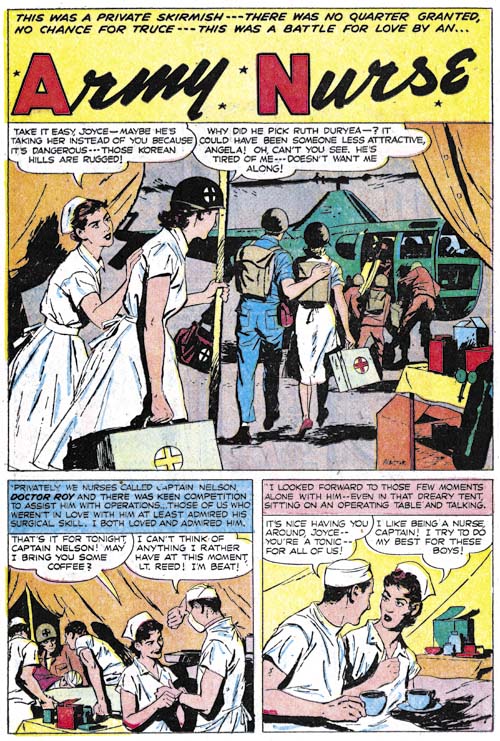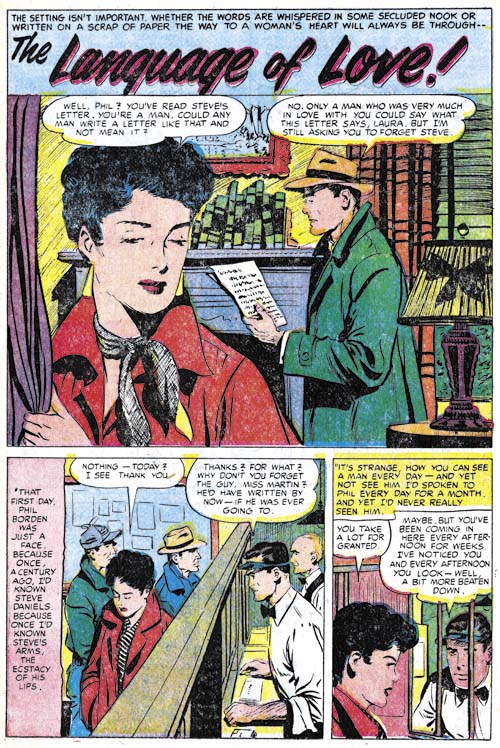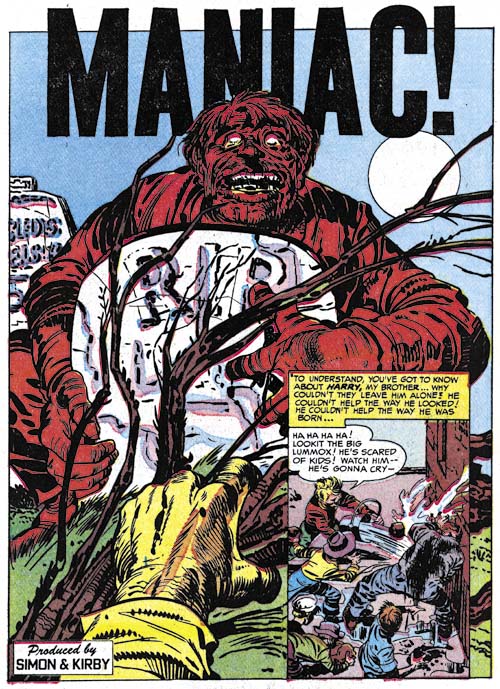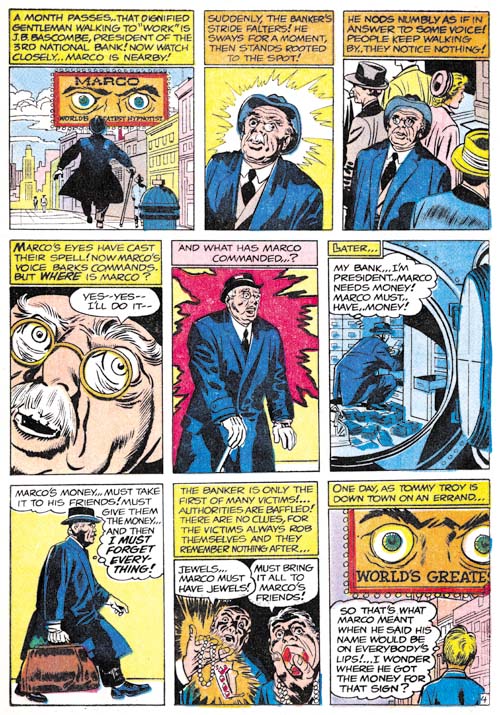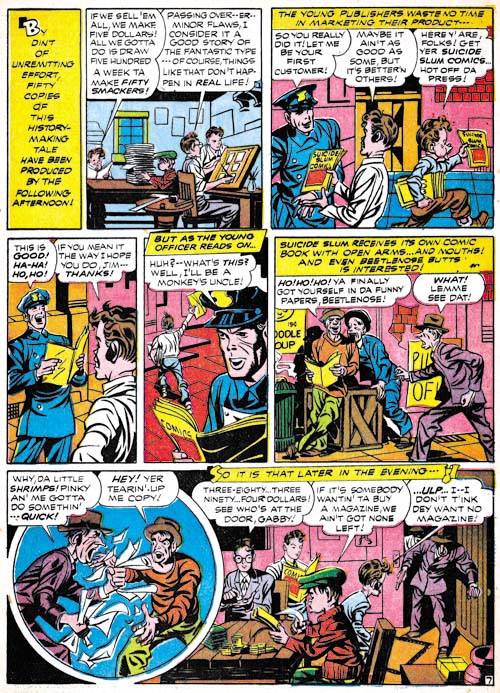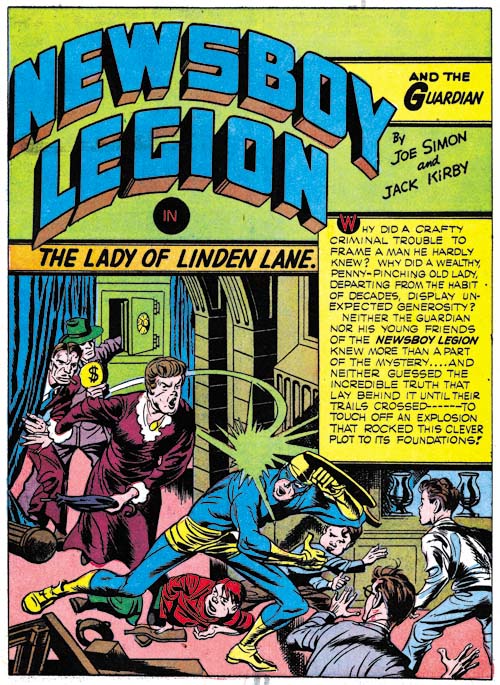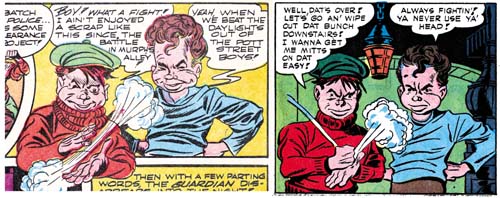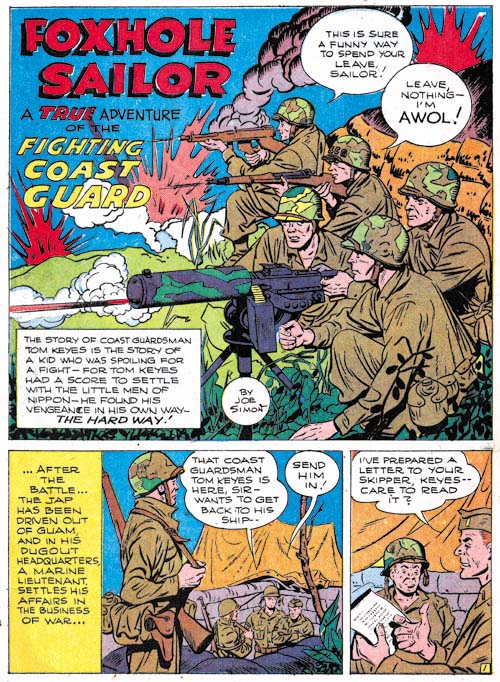(December 1954 – June 1955: Young Romance #75 – #77, Young Love #63 – #65, Young Brides #20 – #22, In Love #3 – #5)

Number of Romance titles 1947 – 1958 (the period covered in this chapter is shaded in blue)
Comic book publishers were in trouble. One indication of this is the number of romance titles had reached a low point. This had happened a couple times before but previously there was a recovery, however not this time. While the number of romance titles will plateau for a while the number of romance comic publishers would continue to decline (The Real Reason for the Decline of Comics).
Simon and Kirby might not have noticed the trouble in the industry before but they could hardly miss it now. Young Romance and Young Love, two of the titles that Joe and Jack produced for Prize, had been monthlies for many years but with the December issues became bimonthlies. Something very odd happened with the February releases, there were none. Both Young Romance and Young Love should have come out that month but would only reappear in April (their next schedule date). In “The Comic Book Makers” Joe remarks on some problems that developed when the owners of Prize noticed that Simon and Kirby had recycled old art. Perhaps this is the explanation for the lost February. (So far I have not identified this reused art but this is not surprising considering the thousands of pages of romance art that Simon and Kirby produced. But there was Fighting American story from this time period that was based on an old Manhunter story (Fighting American, Jumping the Shark). In his book Joe mentions a November 1954 meeting that came about due to this problem. Add a couple of months (because comic cover dates are advanced) and that would be January very near the lost February.
Joe and Jack were also publishing their own comics but there were no lost months for their In Love. However In Love #4 (March 1955) would be the last issue Simon and Kirby would publish themselves. Their distributor, Leader News, was particularly hit by a public backlash against comics. With the failure of Leader News, Simon and Kirby would turn to Charlton to publish their titles. Charlton was notorious for their low pay scale so I suspect that whatever deal they made with Joe and Jack was not that great.
In this serial post I like to provide the line up of the artists based on their productivity. During the period covered in this chapter that would be Bill Draut (61 pages), Jo Albistur (31 pages), Bob McCarty (26 pages), Ann Brewster (25 pages), Jack Kirby (19 pages), John Prentice (11 pages), Ross Andru (12 pages), Leonard Starr (4 pages), Art Gates (3 pages) and Mort Meskin (2 pages). I will comment on most of these artists below. However this list is very incomplete as there are a number of artists that I have not been able to identify. While the individual contributions of these unidentified artists were not great, combined they provided 107 pages of art.
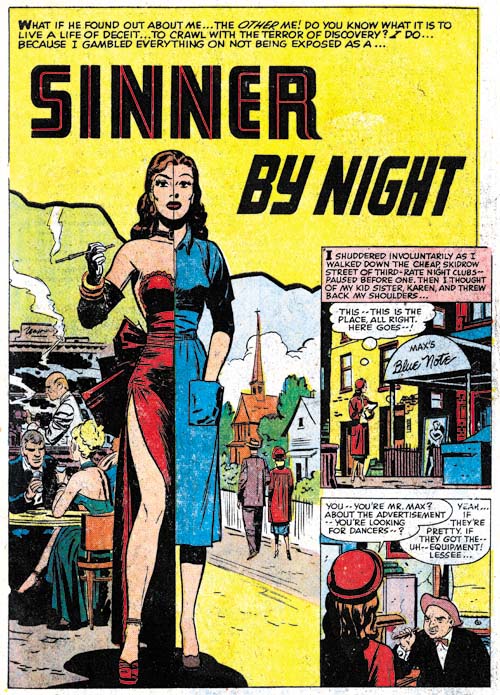
Young Brides #20 (December 1954) “Sinner by Night”, art by Bill Draut
Bill Draut was not only the most productive romance artists during this period he was the most important one in other ways as well. Bill did 8 of the 9 lead stories for the Prize titles. He also provided 6 covers for Prize and 1 for In Love. All these covers appear to be created by Bill specifically for the cover and were not recycled art from a story splash as recently was often the case.

Young Love #63 (December 1954) “Another Love”, art by Bill Draut
Draut was a real work horse of the Simon and Kirby studio. While not as prolific as Jack Kirby or Mort Meskin, it seems Simon and Kirby could always count on Bill to provide great art. But there is something very unusual about “Another Love”. It starts out in a typical Draut manner but the following pages look different. The characters all look like they were drawn by Draut but the way the story is graphically told does not look like his.

Young Love #63 (December 1954) “Another Love” page 6, pencils by unidentified artist
The last page of “Another Love” provides the answer. Panels 4 to 6 do not look like Draut’s pencil at all. It would appear that this story was drawn, or at least laid out, by another artist. Draut’s inking through most of the story helps hide this fact but either he did not ink the last page or did so with less deviation from the original pencils. Some experts have claimed that Simon and Kirby provided Draut with layouts, at least on occasion. However I have found no evidence to support that claim. This is the first example that I have seen of Draut working on art provided by another artist, although in this case it is not Kirby. Bill Draut was not a naturally prolific artist and I suspect that his recent workload caused him to turn to another artist for help. “Another Love” is the only story from this period that this seemed to be the case; all others look like Draut’s work alone.

Young Brides #22 (May 1955), art by Mort Meskin
In terms of numbers Mort Meskin’s contribution to this period was pretty meager two pages. Meskin’s period of work for Simon and Kirby is drawing to an end as he increasingly depends on working for DC. It is clear, however, that Simon and Kirby still valued Meskin’s contribution as both pages were covers.

Young Brides #20 (December 1954) “My Heart’s Torment”, art by John Prentice
John Prentice’s contribution was rather meager during this period (11 pages and no covers). Prentice was normally an active presence in Simon and Kirby’s romance comics and his contribution during the period covered by the last chapter was significant. I have no explanation for his relative absence now. “My Heart’s Torment is a rather nice story and although it may not be obvious at a glance the splash panel is actually part of the story. This format was very commonly used by all artists about a year earlier but almost completely abandoned since. Prentice seems to be the last artist who would sometime use this technique.

Young Brides #21 (March 1955) “Bad Impression”, art by Bob McCarty
In the past I have often confused Bob McCarty’s work from this period with that by John Prentice. McCarty style is much easier to distinguish in both earlier and later periods but for a while his style look liked Prentice’s. I suspect that this was due to both artists being influenced by Alex Raymond’s Rip Kirby syndication strip. The easiest way to distinguish the two is that McCarty’s men have larger eyes and faces that are not quite so long. While Bob was absent from the previous period his productivity exceeds Prentice during the current one (26 pages).

Young Love #65 (June 1955) “The Wild One”, art by Jo Albistur
Jo Albistur was a recent contributor to the Simon and Kirby productions. Jo was from Argentina and would only work for Joe and Jack for about a year. He did some other comic book work but not a lot. Ger Apeldoorn has sent me scans of a cartoon that Albistur did for Humorama. I do not include it her because they are stylistically far removed from his comic book work and I prefer to keep my blog at a GP level and the Humorama pieces are decidedly rated R. While only a relatively newcomer, Albistur provided a substantial amount of art for this period (31 pages). While Albistur is not very well known he is one of my favorite romance artists.
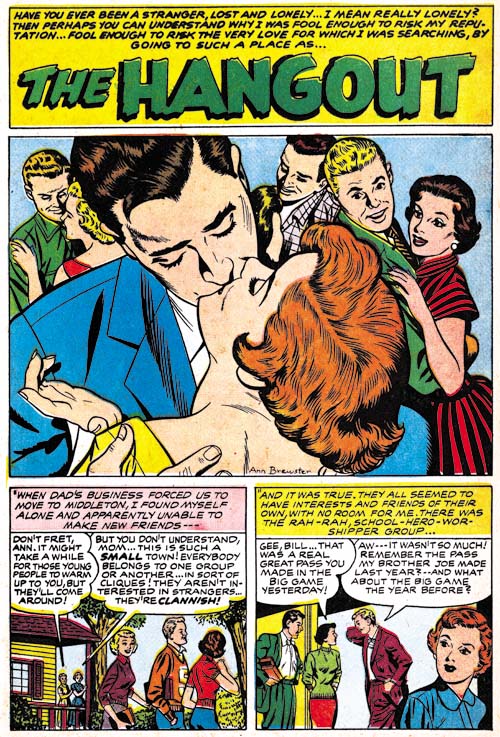
Young Romance #77 (June 1955) “The Hangout”, art by Ann Brewster
Ann Brewster was another recent but much used artists. Some years ago she had done a little work for Simon and Kirby (Art of Romance, Chapter 9). Ann is another of my favorites and Simon and Kirby were obviously impressed by her as well. In fact she was one of the small group of artists who provided cover art for the Prize romance comics while Kirby was busy taking care of business (the other cover artists were Bill Draut, Mort Meskin, John Prentice and Bob McCarty). However Brewster’s covers art was not originally created for that purpose but rather derived from the splash from her story art. Simon and Kirby had converted splash art into covers before. It is the sort of thing Joe Simon would do in the future so I suspect he rather than Jack was behind these efforts.

Young Romance #75 (December 1954) “Too Wise to fall in Love”, art by Art Gates
Art Gates has returned to providing only single page pieces and not many of them either (3 pages). But such single page works seemed to have been a specialty of Gates. Art could provide either cartoons or more realistic art but there seemed no place for his gag cartoons in the Simon and Kirby romance comics.

Young Romance #75 (December 1954) “Too Plain for Love”, pencils by Ross Andru
There are two stories (12 pages) by Ross Andru during this period. As I mentioned in the last chapter, these stories by Andru were almost certainly obtained from left over work when Mikeross publishing failed (the publishing company owned by Mike Esposito and Andru Ross). “Too Plain for Love” was converted into a Nancy Hale story but it is not clear if there were any modifications beyond the title added to the top of the splash page. The story is very unusual in have the captions written in a cursive script.

Young Love #63 (December 1954) “College Romeo”, art by unidentified artist and Ross Andru
The lady in the splash in “College Romeo” also appears to be drawn by Ross Andru. The rest of the art, however, was clearly done by another, less talented, artist. I suspect this is another worked picked up from the failed Mikeross publishing. The panel layout for the splash page is the same as that used by the stories that were completely done by Andru but this is not too significant because this was a commonly used formula.

Young Love #63 (December 1954) “Lovely Liar”, art by unidentified artist
As I mentioned at the start of this post, there were quite a few artists working for Simon and Kirby during this period that I have not been able to identify. I will not be discussing them all but I thought I would provide a few examples.

Young Romance #75 (December 1954) “Personal “Secretary”, art by unidentified artist
The artist for “Personal Secretary” might have been the same one who did the previous example, “Lovely Liar”.

Young Romance #75 (December 1954) “Light of Love”, art by unidentified artist
The woman in the splash panel of “Light of Love” was done in a style somewhat like that of Ross Andru. I am not, however, convinced that Andru actually worked on this piece and it maybe nothing more then the actual penciler being influenced by Andru. Note the panel layout common to this page and the two previous examples. While a vertical splash panel is not that unusual in Simon and Kirby productions, that combined with tall narrow story panels is. Nor is this format found in any of the stories drawn by Ross Andru. I am sure that these pieces were picked up from a failed comic book title but perhaps from a publisher other than Mikeross.

Young Brides #20 (December 1954) “My Darkest Hour”, art by unidentified artist
Parts of “My Darkest Hour” remind me of the work of Bob Powell but not enough to convince me he actually drew the piece. I remember it has been said that he employed artists to help with his work load. Perhaps this is a case of a studio hand producing a Powell imitation. Note the rather nice touch of placing the story title in the theater marquee.

In Love #5 (May 1955) “New Flame”, art by unidentified artist
Artists new to Simon and Kirby romance productions were not limited to the Prize titles but appeared in their own In Love as well. The first three issues of In Love included a very long story that left room only for a single backup story and some single page pieces. However use of a long story was dropped with In Love #4. This allowed for a greater number of artists to appear. Some of the artists such as Bill Draut, Bob McCarty and Art Gates appeared in the Prize titles as well. One artist, Leonard Starr, had worked for Simon and Kirby in the past but only infrequently in recent times. And yes there are artists that I have not yet identified.
Each publisher tended to have his own house style. While “New Flame” is not too different from the typical Simon and Kirby story it reminds me much more of work that appeared in the Harvey romance comics. In fact the use of lower case letters in captions was typical of one of the letters employed by Harvey. The use by Simon and Kirby of art that originally was meant for Harvey occurred previously (Art of Romance, Chapter 13) but that was during the romance glut. During the glut Harvey cancelled some romance titles and put other on hold. Therefore it seems reasonable that Harvey might have wanted to unload some of his art. But while Harvey probably suffered decreased sales during this period, I do not believe he cancelled any titles. So was this really Harvey art? And if so, how did Simon and Kirby get a hold of it?

In Love #3 (January 1955) “Search for Inspiration” (original art), pencils by Jack Kirby, inks by Joe Simon
I have previously written on Jack Kirby’s contribution to In Love #3 (In Love #3 and Artist Loves Model). While Kirby’s piece for In Love #3 was a long one most of it was recycled art from a failed syndication attempt. This relative absence of Kirby from even his and Joe’s Mainline comics suggests that Jack was more involved in business matters then he previously had been.

In Love #5 (May 1955), art by Jack Kirby
As mentioned earlier, Simon and Kirby’s own publishing company, Mainline, failed due to financial difficulties that the distributor Leader News encountered during a public backlash at comic books. Joe and Jack made a deal with Charlton comic to publish the Mainline titles including In Love. The fifth issue was the first Charlton published one and it featured a beautiful Kirby drawn and inked cover. The original art still exists but has the title Exciting Romances. Apparently Simon and Kirby were using it as portfolio piece to show perspective publishers.
If nothing else it makes a nice end to a chapter for a period with very little Kirby art.
Chapter 1, A New Genre (YR #1 – #4)
Chapter 2, Early Artists (YR #1 – #4)
Chapter 3, The Field No Longer Their’s Alone (YR #5 – #8)
Chapter 4, An Explosion of Romance (YR #9 – #12, YL #1 – #4)
Chapter 5, New Talent (YR #9 – 12, YL #1 – #4)
Chapter 6, Love on the Range (RWR #1 – #7, WL #1 – #6)
Chapter 7, More Love on the Range (RWR #1 – #7, WL #1 – #6)
Chapter 8, Kirby on the Range? (RWR #1 – #7, WL #1 – #6)
Chapter 9, More Romance (YR #13 – #16, YL #5 – #6)
Chapter 10, The Peak of the Love Glut (YR #17 – #20, YL #7 – #8)
Chapter 11, After the Glut (YR #21 – #23, YL #9 – #10)
Chapter 12, A Smaller Studio (YR #24 – #26, YL #12 – #14)
Chapter 13, Romance Bottoms Out (YR #27 – #29, YL #15 – #17)
Chapter 14, The Third Suspect (YR #30 – #32, YL #18 – #20)
Chapter 15, The Action of Romance (YR #33 – #35, YL #21 – #23)
Chapter 16, Someone Old and Someone New (YR #36 – #38, YL #24 – #26)
Chapter 17, The Assistant (YR #39 – #41, YL #27 – #29)
Chapter 18, Meskin Takes Over (YR #42 – #44, YL #30 – #32)
Chapter 19, More Artists (YR #45 – #47, YL #33 – #35)
Chapter 20, Romance Still Matters (YR #48 – #50, YL #36 – #38, YB #1)
Chapter 21, Roussos Messes Up (YR #51 – #53, YL #39 – #41, YB #2 – 3)
Chapter 22, He’s the Man (YR #54 – #56, YL #42 – #44, YB #4)
Chapter 23, New Ways of Doing Things (YR #57 – #59, YL #45 – #47, YB #5 – #6)
Chapter 24, A New Artist (YR #60 – #62, YL #48 – #50, YB #7 – #8)
Chapter 25, More New Faces (YR #63 – #65, YLe #51 – #53, YB #9 – #11)
Chapter 26, Goodbye Jack (YR #66 – #68, YL #54 – #56, YB #12 – #14)
Chapter 27, The Return of Mort (YR #69 – #71, YL #57 – #59, YB #15 – #17)
Chapter 28, A Glut of Artists (YR #72 – #74, YL #60 – #62, YB #18 & #19, IL #1 & #2)
Chapter 29, Trouble Begins (YR #75 – #77, YL #63 – #65, YB #20 – #22, IL #3 – #5)
Chapter 30, Transition (YR #78 – #80, YL #66 – #68, YBs #23 – #25, IL #6, ILY #7)
Chapter 30, Appendix (YB #23)
Chapter 31, Kirby, Kirby and More Kirby (YR #81 – #82, YL #69 – #70, YB #26 – #27)
Chapter 32, The Kirby Beat Goes On (YR #83 – #84, YL #71 – #72, YB #28 – #29)
Chapter 33, End of an Era (YR #85 – #87, YL #73, YB #30, AFL #1)
Chapter 34, A New Prize Title (YR #88 – #91, AFL #2 – #5, PL #1 – #2)
Chapter 35, Settling In ( YR #92 – #94, AFL #6 – #8, PL #3 – #5)
Appendix, J.O. Is Joe Orlando
Chapter 36, More Kirby (YR #95 – #97, AFL #9 – #11, PL #6 – #8)
Chapter 37, Some Surprises (YR #98 – #100, AFL #12 – #14, PL #9 – #11)
Chapter 38, All Things Must End (YR #101 – #103, AFL #15 – #17, PL #12 – #14)




